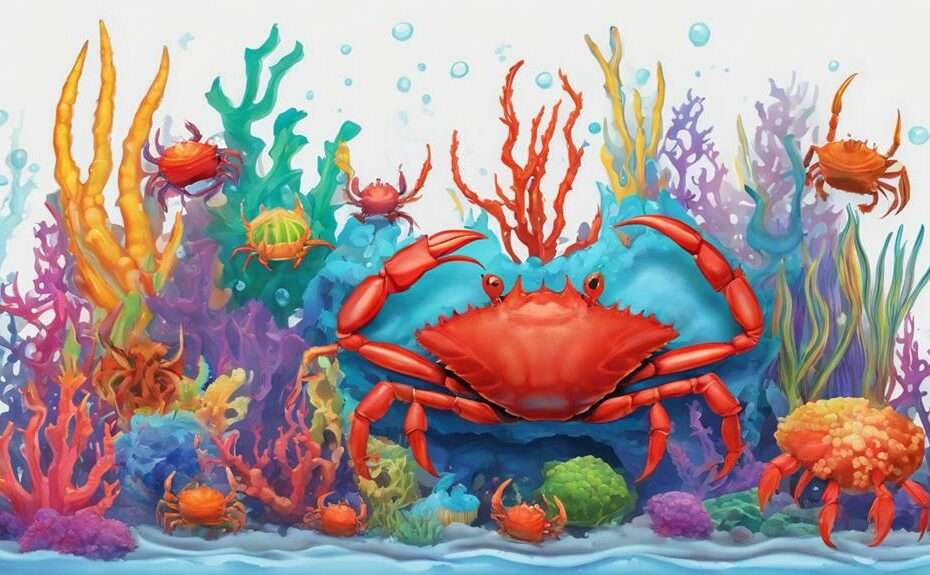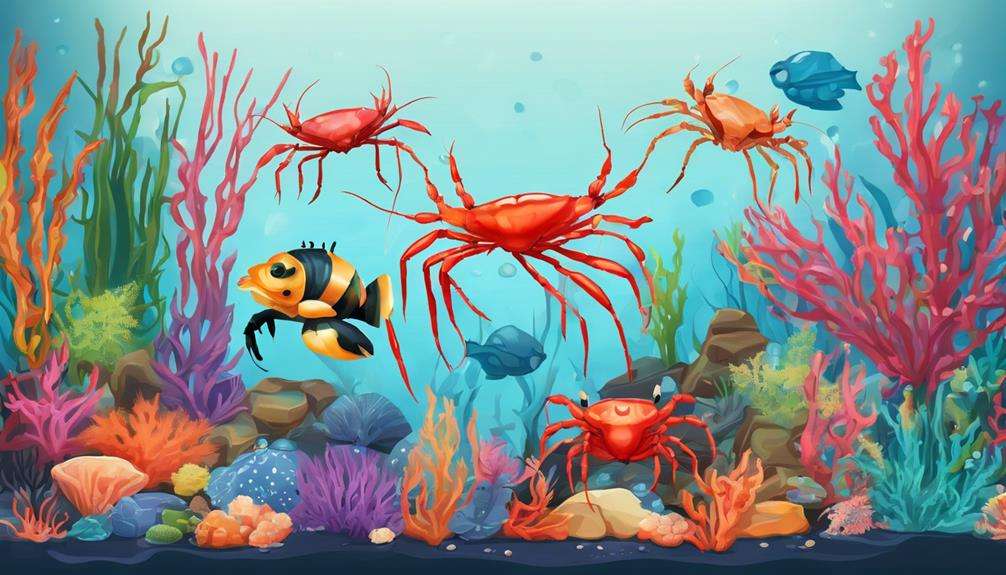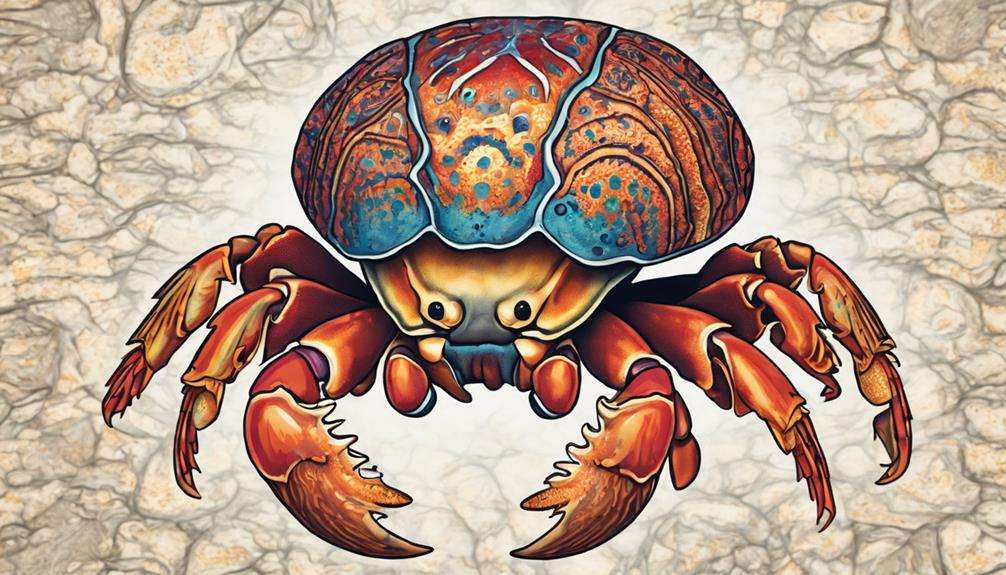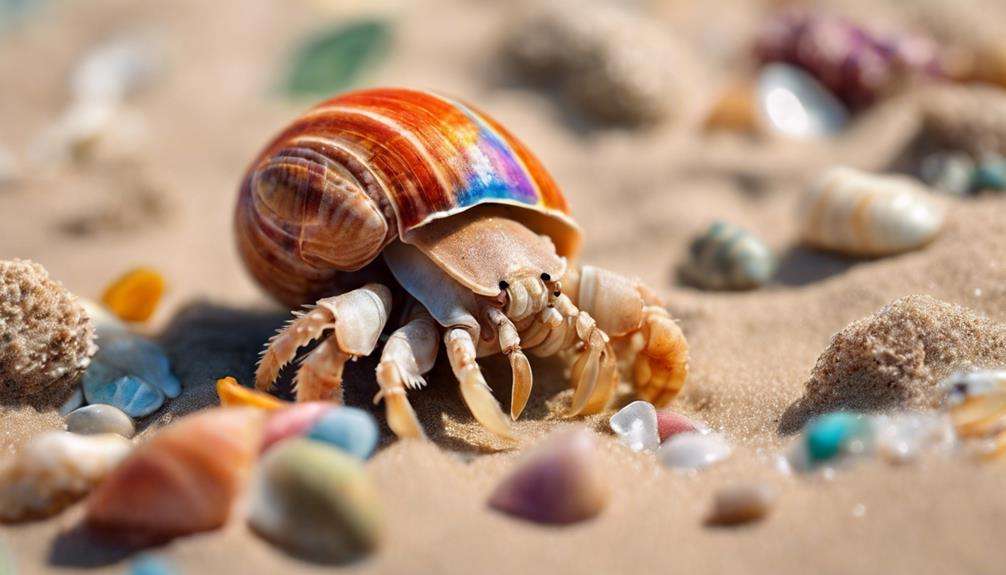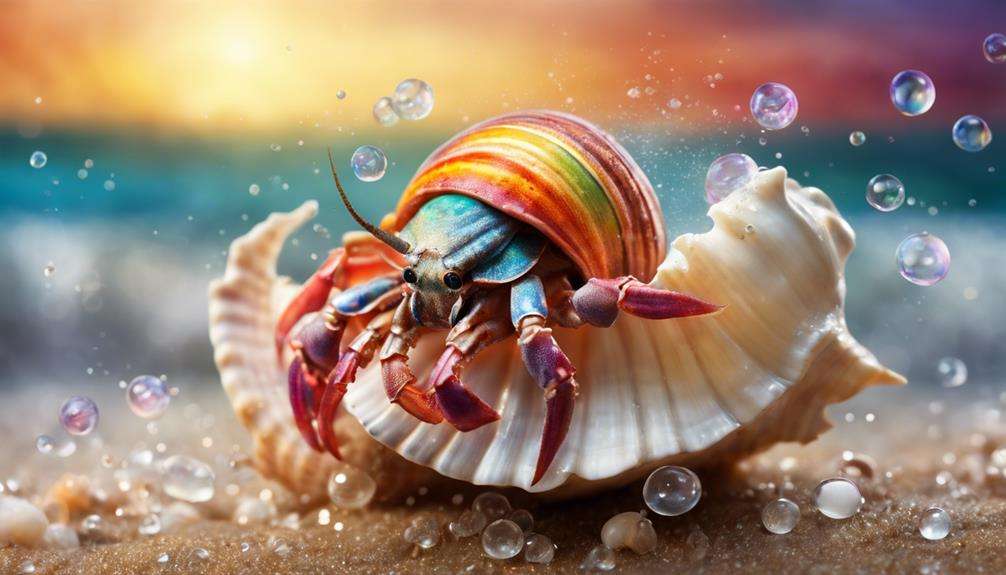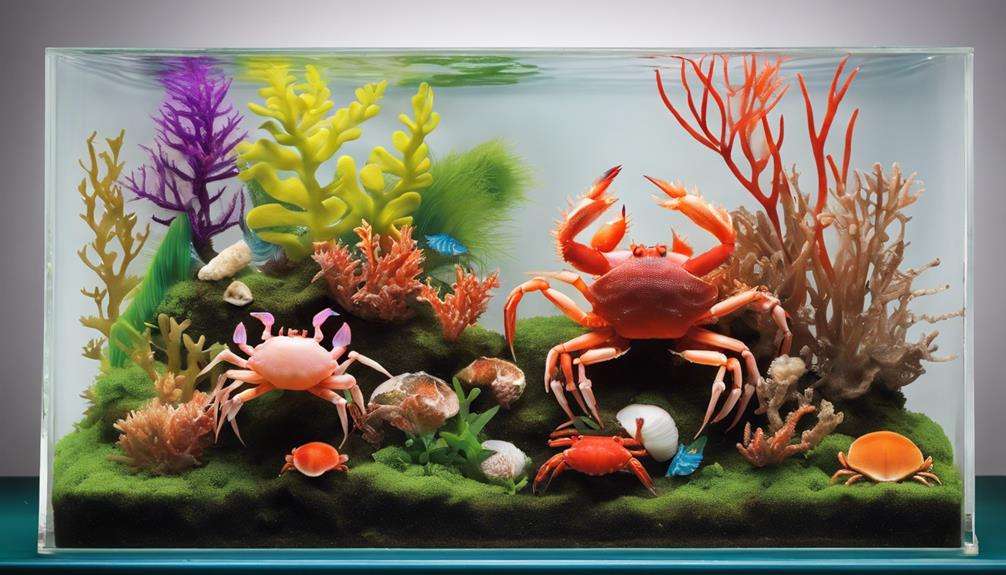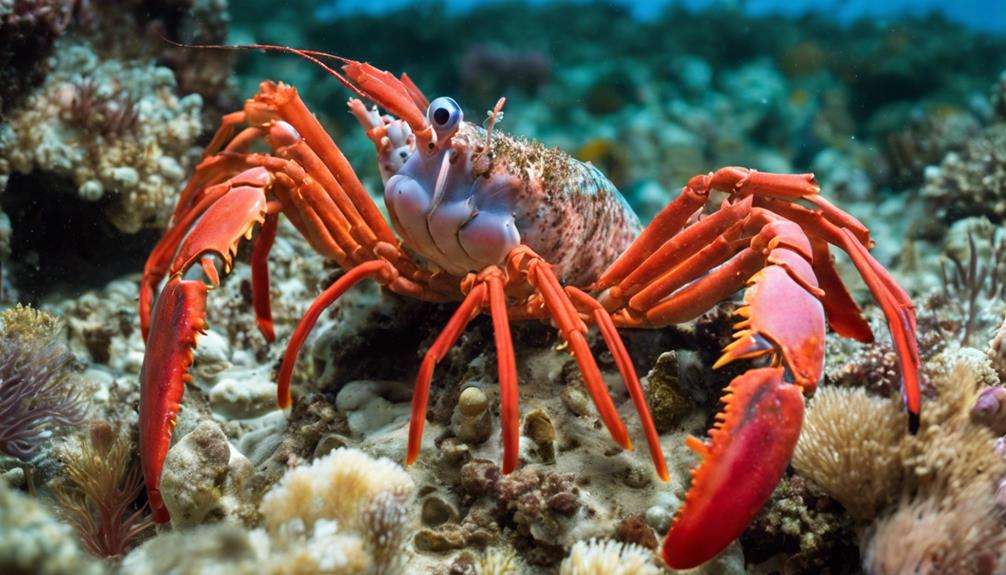So, you think you've mastered the art of aquarium keeping, eh? Well, think again. When it comes to adding a touch of sophistication and challenge to your aquatic hobby, breeding exotic crustaceans might just be the next big thing for you.
Imagine the allure of nurturing creatures with unique characteristics that will set your tank apart from the rest. But before you dive into this intriguing world, let's take a closer look at seven exotic crustaceans that are perfect for home breeding.
Key Takeaways
- Exotic crustaceans offer vibrant colors and interesting behaviors for home aquariums.
- Breeding them provides educational opportunities to learn about unique biology and conservation.
- Tank conditions like water quality, temperature, and diet are crucial for successful breeding.
- Responsible breeding practices contribute to biodiversity conservation efforts.
Procambarus Alleni
Have you ever wondered about the captivating features of Procambarus alleni, commonly known as the Florida Blue Crayfish? These stunning creatures are a favorite among freshwater aquarium enthusiasts and shrimp keepers due to their striking blue coloration and fascinating behaviors. Originating from Florida and Georgia, these crayfish thrive in freshwater habitats like swamps, streams, and lakes.
In captivity, Florida Blue Crayfish are relatively easy to care for as they have an omnivorous diet, enjoying plant matter, insects, and small aquatic organisms. Their burrowing nature adds an interesting dynamic to their tank environment, with these crayfish creating intricate tunnel systems in the substrate.
Breeding Procambarus alleni can be a rewarding experience for aquarists as they are prolific egg producers and exhibit intriguing parental care behaviors. Watching these crayfish tend to their eggs and young can be a fascinating insight into their natural behaviors, making them a popular choice for those looking to delve into the world of crayfish breeding.
Geosesarma Dennerle
Geosesarma Dennerle, commonly known as the Vampire Crab, are fascinating creatures originating from Java, Indonesia. These small crabs boast vibrant hues of oranges, reds, and blues, making them a visually striking addition to any tank.
To successfully breed Geosesarma Dennerle, providing a well-aerated aquatic setup, a balanced diet, and ample hiding spots is crucial.
Breeding Geosesarma Dennerle
Originating from Indonesia, the Vampire Crab, also known as Geosesarma Dennerle, presents aquarists with a captivating breeding challenge due to its specific environmental needs and behaviors. When breeding Geosesarma Dennerle, providing adequate hiding spots is crucial for their overall well-being and successful reproduction. These crabs prefer secluded areas where they can retreat and feel secure during the breeding process.
Incorporating caves, driftwood, or artificial shelters in the aquarium setup can encourage breeding behavior and protect vulnerable offspring. Ensuring a brackish water environment with the right salinity levels and maintaining stable water parameters are essential for the breeding success of Geosesarma Dennerle.
Care Tips for Geosesarma
When caring for Geosesarma Dennerle, ensure a humid environment with access to both land and water to meet their specific needs. Maintain humidity levels between 70-80% by misting the tank regularly and providing a shallow water dish.
Geosesarma require hiding places like driftwood, rocks, and live plants to feel secure and exhibit natural behaviors. Ensure the tank has enough substrate for burrowing and molting, as well as structures for climbing and perching above the waterline.
Monitoring the temperature between 72-78°F is essential for their well-being. Remember to provide enough varied diet options, including algae, small invertebrates, and commercial foods.
Cherax Quadricarinatus
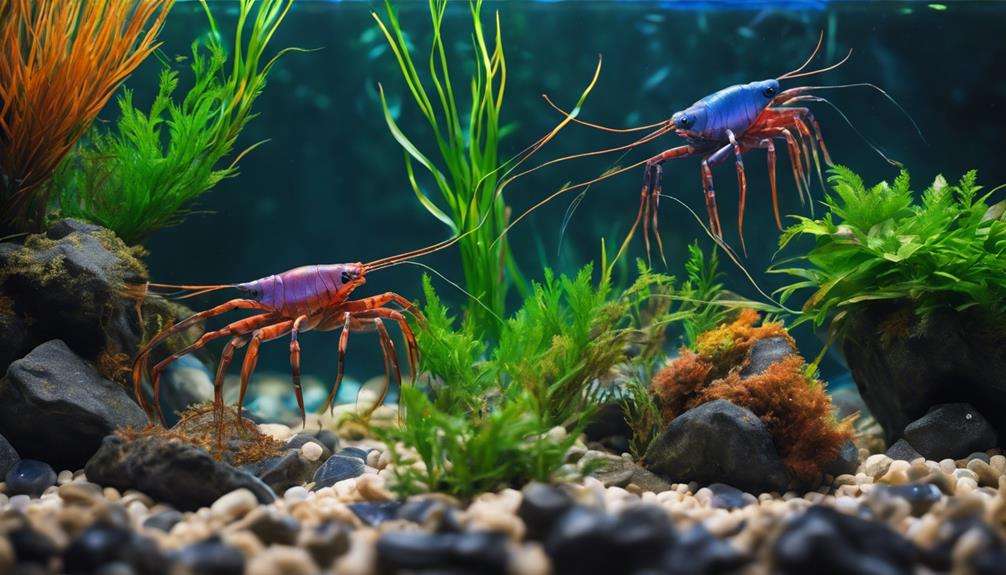
When considering breeding Cherax quadricarinatus, it's crucial to understand their specific requirements.
These crayfish thrive in large tanks with ample hiding spots and appropriate water parameters.
To successfully breed them, you must closely monitor their molting and mating behaviors to ensure their well-being and reproduction.
Breeding Requirements for Cherax
Breeding Australian red claw crayfish, also known as Cherax Quadricarinatus, requires careful attention to tank size, water conditions, diet, and selection of compatible pairs.
For successful breeding, provide a large tank of at least 20 gallons per individual to accommodate breeding pairs. Maintain a temperature range between 75-82°F and ensure slightly alkaline water with a pH of 7.0-8.0. Cherax Quadricarinatus are omnivores; offer a varied diet of high-quality pellets, vegetables, and occasional live or frozen foods.
Select breeding pairs based on size and health, with females generally smaller and rounder. Create a conducive environment by incorporating hiding spots, caves, and plants in the tank to encourage breeding behavior among Cherax Quadricarinatus.
Ideal Habitat Conditions
In creating an optimal habitat for Cherax Quadricarinatus, ensuring appropriate water temperature, pH levels, and structural elements is crucial for their well-being and breeding success. These shrimp thrive in freshwater environments with temperatures ranging between 75-85°F and pH levels of 7.0 to 8.0.
To support their active nature and breeding behaviors, provide at least 20 gallons of water per crayfish in a spacious tank. Incorporate rocks, plants, and other hiding spots to mimic their natural habitat and promote a sense of security.
Regular water changes are essential to maintain water quality and keep the environment conducive to breeding. Due to their popularity, these crustaceans have become sought-after additions to home aquariums, requiring careful attention to habitat conditions for their overall health and successful breeding.
Reproduction and Care
To ensure successful reproduction and care for Cherax Quadricarinatus in a home breeding environment, meticulous attention to water quality, temperature, and tank conditions is paramount.
- Maintain Optimal Water Quality:
- Cherax Quadricarinatus requires clean, well-oxygenated water to thrive and reproduce successfully.
- Regular water changes and filtration are crucial to remove waste and maintain stable water parameters.
- Test water regularly for ammonia, nitrites, and nitrates to ensure a healthy environment for the crayfish and their offspring.
- Provide Nutritious Food:
- Offer a varied diet including high-quality commercial foods, vegetables, and protein sources like dwarf shrimp.
- Ensure adequate calcium availability for molting and shell development.
- Avoid overfeeding to prevent water quality issues and obesity in the crayfish.
- Monitor Tank Conditions:
- Maintain a stable temperature between 75-82°F for optimal breeding conditions.
- Provide hiding spots and structures for the crayfish to feel secure.
- Regularly check tank equipment and conditions to prevent any potential hazards to the crayfish.
Mictyris Guinotae
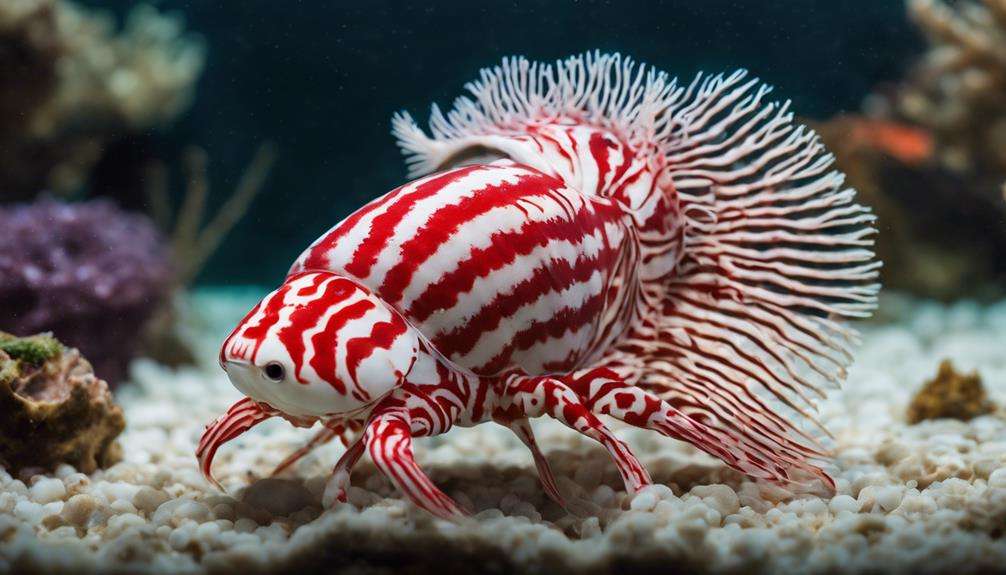
Found in the Indo-Pacific region, Mictyris guinotae, commonly known as the 'Blue Soldier Crab,' showcases a striking blue coloration with red spots on its carapace, resembling a military uniform. These social creatures are often observed in large groups on sandy beaches or mudflats, where they utilize their vibrant colors for communication and mating displays. As omnivores, Mictyris guinotae feed on detritus, algae, and small invertebrates, contributing significantly to ecosystem balance by recycling nutrients.
Breeding Mictyris guinotae in captivity poses challenges due to their specific environmental requirements and social dynamics. However, successful breeding can be rewarding for enthusiasts willing to invest time and effort. Providing a suitable habitat that mimics their natural environment is crucial for their well-being and reproduction. Maintaining proper water quality, temperature, and sufficient space for social interactions are essential aspects to consider when attempting to breed these captivating crustaceans. With attention to detail and a thorough understanding of their behavior, breeding the Blue Soldier Crab can be a fascinating endeavor for dedicated hobbyists.
Parathelphusa Pantherina
With its striking black and orange coloration reminiscent of a panther, the Parathelphusa Pantherina, also known as the Panther Crab, is a captivating freshwater crustacean species originating from Southeast Asia. Here are some key points about this intriguing creature:
- Origin: Panther Crabs are native to Southeast Asia, particularly countries like Thailand and Malaysia, where they inhabit freshwater environments such as streams and rivers.
- Coloration: These crustaceans are named for their striking resemblance to a panther due to their black and orange coloration. This unique appearance makes them a popular choice for aquarists looking to add a visually appealing species to their tanks.
- Diet: Panther Crabs are omnivores, meaning they have a varied diet. In the wild, they feed on algae, plant matter, and small invertebrates. When kept in captivity, it's essential to provide them with a balanced diet to ensure their health and well-being.
Panther Crabs can make an excellent addition to a freshwater aquarium, adding both color and interest to the tank.
Uca Vomeris

Inhabiting intertidal zones of mangrove forests and sandy beaches in tropical regions, the Uca Vomeris, commonly known as the fiddler crab, is a small and colorful crustacean species known for its intriguing behaviors.
The males of this species have an oversized claw used for courtship displays. These crabs exhibit a unique feeding behavior where they use their smaller claw to scoop up sediment and filter out organic matter, a fascinating sight to observe in an aquarium setting.
When breeding Uca Vomeris, it's crucial to replicate their natural habitat. These crabs require brackish water conditions, a mix of saltwater and freshwater. The female will carry the eggs under her abdomen until they hatch, showcasing exceptional maternal care.
Observing this process can provide valuable insights into the reproductive biology of these fascinating creatures. Creating a suitable environment with attention to water salinity and providing adequate space for breeding activities will enhance the success and enjoyment of breeding Uca Vomeris at home.
Macrobrachium Rosenbergii
The Giant River Prawn, scientifically known as Macrobrachium rosenbergii, is a prominent species among freshwater prawns due to its impressive size potential of up to 12 inches. When considering breeding these fascinating crustaceans at home, there are key factors to keep in mind:
- Diet: Macrobrachium rosenbergii have a diverse diet, which includes algae, detritus, small fish, and invertebrates. To ensure their optimal health and growth, a varied diet rich in protein sources is essential for these freshwater prawns.
- Breeding: Breeding Macrobrachium rosenbergii involves creating an environment that supports their reproductive success. This includes providing ample space, maintaining high-quality water conditions, and offering proper nutrition to enhance breeding outcomes.
- Tank Dynamics: Due to their aggressive nature, monitoring tank dynamics is crucial when keeping Macrobrachium rosenbergii. Selecting suitable tank mates and ensuring a harmonious environment will help prevent conflicts and promote the well-being of these impressive freshwater prawns.
Frequently Asked Questions
What Is the Easiest Shrimp to Breed at Home?
The easiest shrimp to breed at home is the Red Cherry Shrimp. They reach maturity quickly, with females carrying eggs for about 30 days before hatching. Provide stable water conditions, hiding spaces, and varied diet for successful breeding.
What Is the Most Profitable Shrimp to Breed?
Breeding techniques, market demand, and genetics research all point to Red Cherry Shrimp (Neocaridina davidi) as the most profitable option. Their ease of care, hardiness, and vibrant colors make them a top choice for shrimp enthusiasts.
What Is the Best Fish to Breed for Profit?
When considering the best fish to breed for profit, focus on tropical fish with high market demand. Utilize effective breeding techniques and setups to maximize profit margins while addressing breeding challenges. Research, plan, and adapt for success.
How Many Shrimp Should I Buy to Breed?
To start breeding shrimp successfully, purchase a group of 10-20 for genetic diversity. Maintain a ratio of 3-5 females per male. Ensure the tank size and water parameters are suitable. Monitor behavior, molting, and reproduction signs closely.
Conclusion
Congratulations on successfully breeding these exotic crustaceans at home! As you gaze into your tank, marvel at the vibrant colors and unique behaviors of these creatures. Remember to provide them with the care they need to thrive, from optimal humidity levels to suitable shells for protection.
Enjoy the mesmerizing sight of a diverse and captivating aquatic environment right in your own home, a true testament to your dedication and passion for these fascinating creatures.
